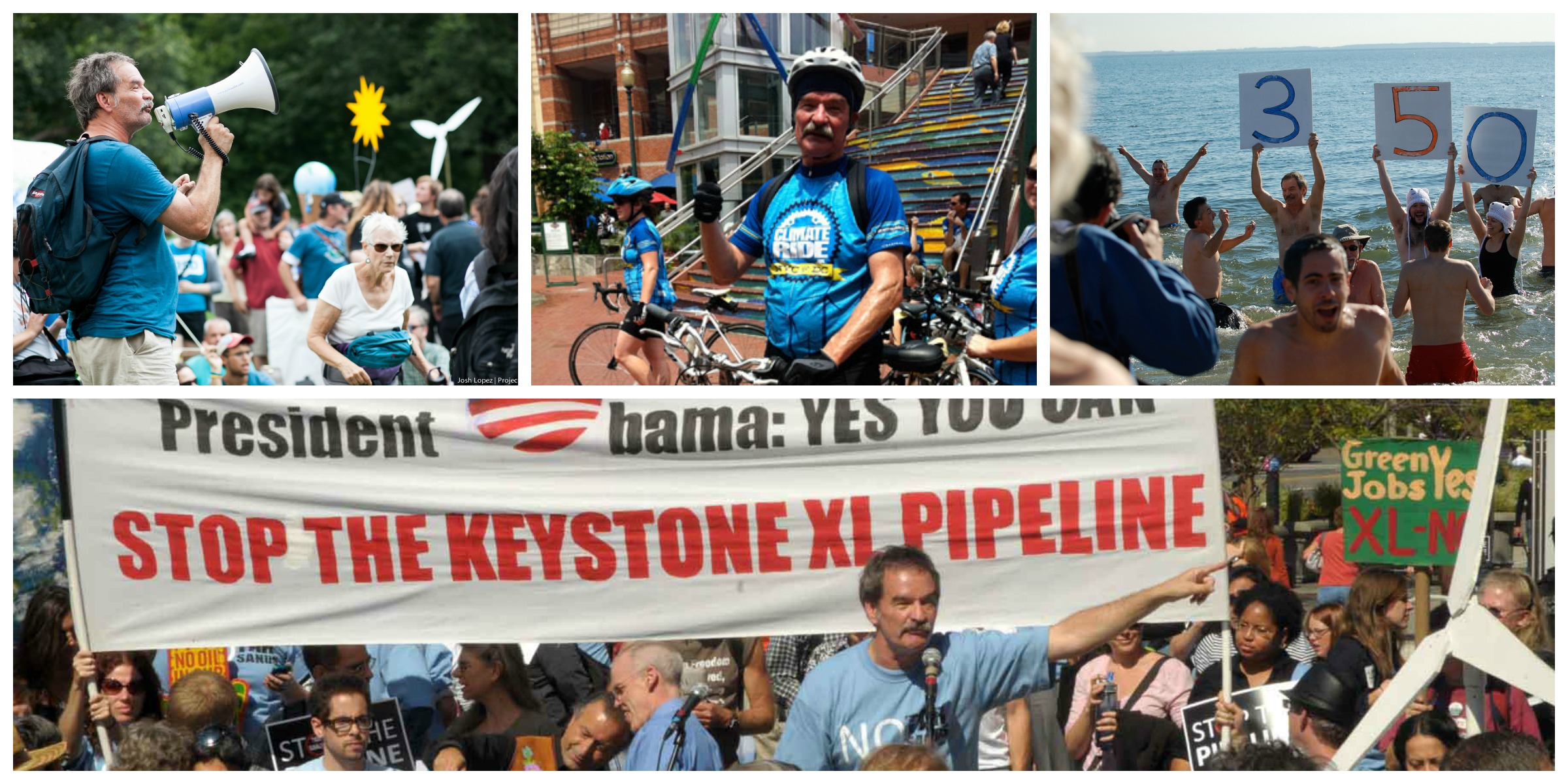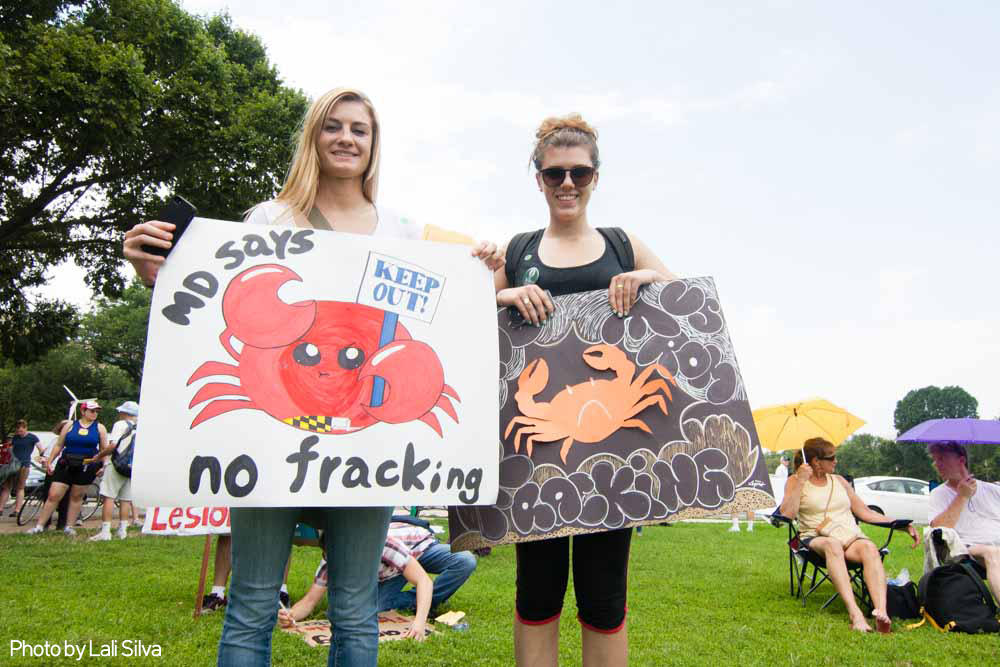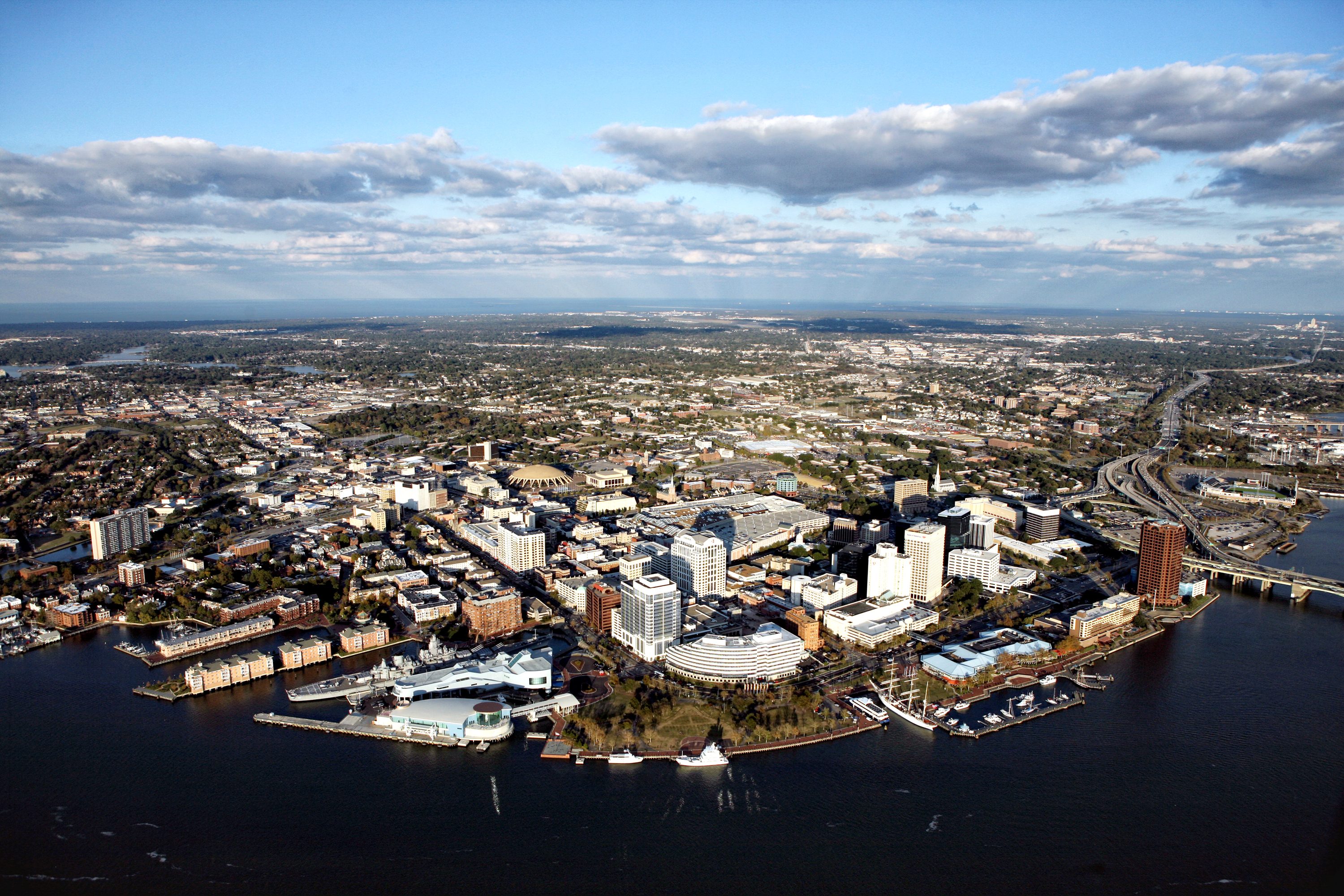It’s official: In the face of possible blizzard conditions, we have decided to postpone the Polar Bear Plunge — to next Saturday, January 30th at National Harbor.
That means we can all stay warm this weekend. And we have one extra week to fundraise — and hit our goal of raising $90,000 to fight climate change! (Plus, a photo of you plunging will look even more impressive against a snowy backdrop.)
Thanks to your outreach, we’re 66 percent of the way to our goal. We have just under $31,000 more to raise to get there, and we know we can do it! We raised $30,000 in the week leading up to last year’s plunge — and that was without a giant snowstorm to set the stage for serious bragging rights.
The keepwintercold.org website is updated with the new date — next Saturday, January 30th — and you can continue using it to recruit sponsors.
Meanwhile, all the logistics for the Plunge will remain the same — just taking place one week later. We’ll be sure to update you next week with all the final details.
Finally, stay safe and warm this weekend, and thank you for your continued dedication to fighting climate change.
2016 VA General Assembly Preview: It Was Not A Coastal Event
We built a movement. Two years ago, CCAN unveiled a new campaign with a singular focus: highlight the urgent need for solutions to flooding and climate change in at-risk areas of Virginia. Over the past two years, CCAN supporters and partnering organizations have advanced our Safe Coast Virginia campaign and turned our top priority legislation, the Virginia Coastal Protection Act (VCPA), into one of the most talked-about climate bills in the state.
We’re not done yet. On Wednesday, the General Assembly convenes for the 2016 legislative session and passage of the VCPA is our main goal. Republican delegate Ron Villanueva and democratic senator Donald McEachin have reintroduced a bill that is badly needed in order to help solve the crisis of flooding in Virginia that is fueled by climate change.
The bill has seen an evolution of late – for the better. In September of last year, Gov. McAuliffe declared a state of emergency for an impending weather event that wreaked havoc in many communities along the east coast – and could’ve been much worse. A McAuliffe administration official said that the severe rain event that caused millions of dollars in damages throughout the commonwealth “was not a coastal event.” Homes in every part of the state were affected by this storm and more homes will be at risk in the future due to climate change.
When this campaign first began, CCAN helped shed light on the significant costs associated with sea level rise along the coast. By now, we all know that the cost to help Hampton Roads adapt to sea level rise is in the billions of dollars. These figures are far too great for localities to bear themselves. What has become increasingly clear is that climate change is fueling severe flooding events throughout the state with more frequency, making communities incredibly vulnerable in every part of the state.
The reintroduced version of the VCPA will provide revenues to localities throughout the state to assist with flooding and climate resilience efforts. I’m proud to have gained the support of the Virginia Municipal League, an organization representing localities throughout the state, who has enthusiastically endorsed the VCPA as a solution to flooding and climate change and will work for its passage. In addition, individual localities from Staunton to Leesburg to Virginia Beach have stepped up to support the VCPA.
There are other bills that we’ll be following this year as well. We’re going to hold legislators accountable for attempts to stall on climate progress by delaying implementation of the Clean Power Plan. We will continue to fight for strengthened clean energy laws and promote the expansion of solar, wind, and efficiency programs as we have successfully done in the past few years. And we will monitor efforts by gas companies to accelerate development of natural gas infrastructure which leads to devastating local and climate impacts.
But one of the biggest challenges facing our lawmakers this session is how to secure the massive amount of resources necessary to begin implementing solutions to sea level rise in Hampton Roads and flooding from severe rain events in localities throughout Virginia. Our elected leaders can take a step forward on climate and begin addressing this problem by passing the VCPA in a few short weeks.
We’ll keep you posted on the VCPA’s progress and other climate-related bills as they make their way through the legislative process in Richmond.
Match alert: Give now and double your impact!
2015 is certain to be the hottest year on record. It’s also the year that I’ve felt more hope for the global climate movement than I have in a very long time. And I’m not alone.
In these final 48 hours of 2015, a group of generous CCAN donors has offered to match dollar-for-dollar every gift to CCAN — up to $7,000.
That means your year-end gift can have double the impact for CCAN and the campaigns you care about!
Click here to make a tax-deductible donation right now, and help us meet this challenge.
We have every intention of making 2016 a year for groundbreaking results. For every effort we undertake, we build as big a coalition as possible and never, ever, ever give up. Here’s why giving to CCAN is critical for the planet:
- We win. Your donation will ensure that we keep Maryland in the lead for envelope-pushing state clean energy policies. We have broader support than we’ve ever had heading into the 2016 General Assembly for our priorities to renew our landmark carbon cap bill and expand our clean electricity standard to 25% by 2020.
- We set the bar high. In the District, we’re launching a first-of-its-kind campaign to put a price on carbon in our nation’s capital. This will be a heavy lift, but we can do it with your support.
- We don’t let up. In Virginia, we will doggedly push to pass our bipartisan Virginia Coastal Protection Act in 2016, supported by cities across the commonwealth, faith and civic leaders, and clean energy businesses. We will also continue to work with statewide and local groups to fight Dominion’s aggressive push for hundreds of miles of fracked gas pipeline crisscrossing our land.
We are so thankful for your support — because none of these campaigns will be successful without funds and activism from people like you. We are also thankful for this matching gift opportunity made possible by CCAN board members who are similarly inspired about the progress we can make together.
In these last hours of 2015, please give generously — and double your impact for CCAN and climate solutions!
And, check out this short video to learn more about what your support helped us accomplish in 2015. As you’ll see, we won hard-fought progress in 2015. But we’ve got a LOT of unfinished business for the New Year:
In the wake of Paris, over 6,000 Virginians call on Governor McAuliffe: Save Our Coast!
Today, the Chesapeake Climate Action Network delivered over a thousand petitions to Governor Terry McAuliffe, demanding action on climate and a plan to save our coast from rising seas.

Today’s delivery is part of a growing call for climate action in Virginia – one that has grown especially loud in the wake of world leaders taking action in Paris last week.
Over the last six weeks, with help from our partners at the Virginia Sierra Club, Appalachian Voices, Virginia Organizing, Environment Virginia, New Virginia Majority and the Virginia Conservation Network, we’ve delivered our 6,000 petitions – from moms, students, business owners, flooding victims and other concerned Virginians across the state – to the Governor, urging him to act on climate and save our coast by supporting the Regional Greenhouse Gas Initiative (RGGI), a regional system that caps and reduces carbon pollution.

Meanwhile, a bipartisan bill that would direct Virginia to join RGGI has gained unprecedented support since it was introduced last spring. The bill, called the Virginia Coastal Protection Act, introduced by Delegate Ron Villanueva (R-Virginia Beach) and Senator Donald McEachin (D-Richmond), would not only cap and reduce Virginia’s carbon pollution, it would also create the first statewide fund to help our communities deal with the impacts of climate change.
City governments across the state – including Virginia Beach, Norfolk, Hampton, Newport News, Fredericksburg, Leesburg, Staunton and Charlottesville – support Virginia joining RGGI.
The powerful Virginia Municipal League and Hampton Roads Planning District Commission both support Virginia joining RGGI.
Virginia’s major newspapers – the Richmond Times-Dispatch and the Virginian Pilot – support Virginia joining RGGI, as does the Washington Post.
Businesses from Hampton Roads to the Valley support Virginia joining RGGI.
Climate groups, environmental groups, fair housing groups, health groups and justice groups support Virginia joining RGGI.

And just last week, nearly 50 people gathered at the General Assembly to mark the end of the Paris climate talks and call on Governor McAuliffe to keep carbon in the ground.
Over the last six weeks, we’ve made it clear that 6,000 Virginians and counting support Virginia joining RGGI too.
Now, the question is: what is Governor McAuliffe going to do?
So far, Governor McAuliffe has refused to support this win-win solution, while remaining stubbornly supportive of a spiderweb of fracked gas pipelines across our farms and forests and offshore drilling along our coast.
Here at CCAN, we know that the actions we take now will help determine how high sea levels rise along our coast and how extreme the weather gets in all of our communities.
Given what’s at stake, it’s more than time for Governor McAuliffe to follow the leadership of world leaders, join this rising tide of support and put his weight behind Virginia joining RGGI. In the wake of Paris, this is the most important step we can take to advance bold climate action here at home.
What happened in Paris? Here's what
My friend Bill McKibben has warned for years that, absent dramatic action on global warming, we will literally have to lower the flags of several nations at the U.N. building in New York. Sea-level rise will wipe out entire countries like the Maldives in the Indian Ocean and Tuvalu in the Pacific. Their national flags will have to be lowered in New York and put away, the nations gone forever. Imagine that.
But last week in Paris, during the international climate talks, negotiators heard the pleas of desperate and courageous island nation activists – and activists like you from all over the globe.
Those negotiators hammered out a Paris Agreement that commits the world to steady reductions in carbon emissions in a way that can keep temperatures “well below” two degrees Celsius.
Scientists say this gives not only the Maldives a chance at survival but also our equally vulnerable U.S. communities closer to home – like the low-lying Eastern Shore of Maryland and coastal Virginia cities like Norfolk.
Now you can help implement the Paris Accord with a year-end gift to CCAN. During this holiday season, donate to CCAN with the knowledge that global accords require local action to succeed.
People across the globe are counting on the United States to do its part to dramatically cut global warming pollution. But with Congress in gridlock, the whole world is literally counting on American states – not just California and New York but all states, like clean-energy leaders Maryland and DC, and climate-vulnerable Virginia – to do much, much more in the next five years.
Imagine that! Our Mid-Atlantic region is key to a global solution. That’s no exaggeration. Which means we need to pass legislation in Maryland in 2016 to increase our clean electricity standard to 25%. We need pass a best-in-the-nation carbon tax in the District of Columbia. We need to fight like hell to pass the bipartisan Virginia Coastal Protection Act in Richmond in 2016.
And we need to go on overdrive to stop new fossil fuel projects that will undermine global progress – like Dominion’s monstrous Atlantic Coast Pipeline for fracked gas.
Make a year-end, tax-deductible gift to CCAN to support the local organizing it will take to make the Paris Accord a success.
We cannot win globally without wins here at home. And CCAN is a truly people-powered group: volunteers and donors like you have been the force behind 13 years of victories – from putting mandatory clean electricity standards in place to shutting down coal plants to passing laws to keep fracked gas in the ground.
With your help, I do not believe we will ever lower any nation’s flag at the United Nations building in New York. And we will not abandon coastal Virginia and Maryland’s Eastern Shore.
I’m totally inspired by the new Paris agreement, and I’m eager to do the hard, determined work it’ll take to turn a new global pact into rapid local progress in 2016.
After you’ve made a donation, check out this essay about the Paris agreement from blogger extraordinaire Joe Romm. You’ll be inspired. But you’ll also see how much work is ahead of us here in America over the next five years. And check out these wonderful photos of Paris activism from our friends at InsideClimate News.
Fredericksburg, Leesburg pass resolutions in support of RGGI
In the final two week of November, the city of Fredericksburg and the town of Leesburg both passed resolutions in support of the Virginia Coastal Protection Act. The votes came on the heels of a number of cities in the Hampton Roads, including Hampton and Virginia Beach, that have also voted to support the bipartisan legislation to allow Virginia to join the Regional Greenhouse Gas Initiative (RGGI).
RGGI is a cooperative effort among nine east state from Maine to Maryland that caps and reduces their emissions from power plants. Under RGGI, power plants in participating states purchase allowances for every ton of carbon pollution that they emit. Virginia could receive as much as $209 million annually from the proceeds from the the allowances, which would be directed towards climate-related flooding mitigation, energy efficiency, renewable, and economic development in southwestern Virginia.
With the General Assembly session just around the corner, momentum is building once again for the Virginia Coastal Protection Act. Last year, the bill narrowly failed to make its way out of the Senate Agriculture, Conservation, and Natural Resources Committee. The bipartisan patrons of last year’s bill, Del. Ron Villanueva (R-Virginia Beach) and Sen. Donald McEachin (D-Richmond), are expected to reintroduce the legislation in the coming weeks.
This time around we’ve built an even broader and more diverse coalition of supporters. Businesses large and small, as well as, housing advocates and social justice organizations are all on board. Scientists are saying that 2015 is well on its way to being the warmest year on record, and we need solutions for coastal Virginia now.
As we approach General Assembly session in January, we will need your help to pass the Virginia Coastal Protection Act. You can find out how to get involved by emailing me at Charlie@chesapeakeclimate.org.
Letter from the Director: Thank you, Ted
Dear CCANers,
Chances are if you know CCAN, you know our National Campaign Coordinator Ted Glick. If you’re a long-time CCAN activist, if you’ve joined one of our annual “polar bear plunges,” protested the fracked gas export facility at Cove Point, walked 100 miles in the summer heat to stop Keystone XL, or picketed outside the Federal Energy Regulatory Commission, you’ve likely met Ted and been inspired by him.
This month, after nearly ten years of service to CCAN, Ted is retiring. Well, retiring is not the right word. He’s stepping back to do more writing and spend more time with his lovely wife Jane and get more involved in local climate fights up in New Jersey where they live. I don’t think Ted will ever slow down. He just won’t be in the official employ of CCAN anymore.
We will miss Ted tremendously. He brought to CCAN a streak of 1960s idealism and a passion for creative street protests. He got peacefully arrested multiple times while advancing CCAN causes. He fasted almost as many times, his last being an 18-day water-only fast outside of the Federal Energy Regulatory Commission last month in DC. He also illegally occupied a ledge in protest at the National Oceanic and Atmospheric Administration. And he wrote and shared a lot of poems. Ted can stand up to tough cops and deaf politicians one moment, then recite a poem the next about the glorious mockingbird he heard during his morning walk that day.
When Ted came to work at CCAN in 2006, there was no national “fossil fuel resistance.” Now Keystone looks finished, coal plants are getting shut down, and fracked gas is finding determined opposition everywhere. Ted played a big role in making that sea change happen.
So, to my friend and colleague and mentor, I say: Thank you, Ted. Thanks for fighting with everything you have against the greatest threat human beings have ever faced. You have made a difference.

Mike Tidwell
Court win increases oil train transparency, but it’s not enough
At the end of the summer, Baltimore Circuit Court Judge Lawrence Fletcher-Hill ruled in favor of safe cities and healthy communities, stating that rail companies must disclose the routes of dangerous oil trains the public. His ruling affirmed that communities have a right to know if dangerous, explosive trains run through their neighborhoods. This lawsuit victory is one part of a growing national movement to stop dangerous oil trains from rolling through communities and spreading a network of dirty fossil fuels. Now, we have a clearer picture of where oil trains actually move throughout Maryland, and what we can do next to stop them!
Oil trains in Maryland enter from states that border us to the north, coming from major oil hubs like Newark and Philadelphia. Following Pulaski Highway (Rte. 40), oil trains roll past Havre de Grace and Aberdeen, and cross Herring Run into Baltimore. Trains then move through the heart of the city, following 26th street into Charles Village, turning south at Jones Falls. At that point, trains enter the Howard Street tunnel, passing directly under the Maryland Institute College of Art, the Department of Health and Mental Hygiene, Maryland General Hospital and the University of Maryland Medical Center, Lexington Market, and the Baltimore Convention Center. Trains exit the tunnel next to a Raven’s stadium parking lot, and wrap around the stadium as it travels south crossing Gwynns Falls, through Westport and then Brooklyn to a shipping terminal on the Fairfield peninsula.

Oil also comes in from the west, directly from Pittsburgh. Trains travel on the CSX railroad line through Cumberland, passing Harpers Ferry, and through Frederick County, where it meets the headwaters of the Patapsco River. It then follows the Patapsco through Monrovia to Ellicot City, where it enters the City through Morrell Park and Mount Winans, where it meets up with the northern rail line to the shipping terminal in Fairfield. Through research, we found out that this puts over 165,000 people in the blast zone in Baltimore. In Baltimore city, these trains predominately run through communities of color and low-income communities, disproportionately putting these people at risk, and is an environmental injustice.
In the past two years, over 100 million gallons of crude oil have been offloaded from oil trains in Baltimore. These numbers come from the State’s Oil Control Program, which is a regulatory agency that requires oil and rail companies to disclose how much oil comes through the state. But here’s the catch: the OCP requires oil companies to report only when over 1 million gallons of crude oil are unloaded from a train in Maryland. This means that if a train is carrying less than 1 million gallons of crude oil (about 35 tankers on a single train), it can be unloaded and stored in Maryland with no need to report this information to the public. It also means that oil trains passing through the state, on their way to oil hubs in the Northeast, for example, go unreported. The real amount of oil that travels through Baltimore and Maryland is still unknown, although it’s almost certain that it’s much, much more than what’s being reported.

The truth is, oil companies are still keeping the public in the dark. Because of this, CCAN will continue to push for public transparency and education surrounding oil trains, and work to make it as hard as possible for oil companies to ship their dirty, explosive fracked oil through the state. Ultimately, oil trains shouldn’t exist, the dangers are too high, and a federal ban should be instituted immediately. However, in Baltimore, we’re calling on the city council to pass a 4 year moratorium on new crude oil shipping terminals, to stop the alarming increase of oil trains in Baltimore. And as we continue into the new year, CCAN will work at the state and national level to make it harder for companies to ship out crude oil.
We know to stop runaway climate change we have to keep fossil fuels in the ground. It turns out, one key way to do this is stopping the transport of fossil fuels, making our fight against oil trains just as important. An excellent report that just came out from Oil Change International proves that point. Our recent legal victory is a great step forward in the fight against fracked oil, but it’s not enough.
If you are interested in volunteering with CCAN to stop explosive oil trains in our region, contact Jon Kenney at jon@chesapeakeclimate.org or 240-396-1985.
New Health Research Underlines Why We Fight Fracking
At CCAN, we’re fighting to keep fracking wells out of our communities — and to stop new pipelines, compressor stations, and export facilities that drive demand for new fracking — because we know that this extreme form of fossil fuel extraction is a disaster for our climate.
But that’s certainly not the only reason we fight fracking. A comprehensive review of scientific studies released this fall underlines how fracking and its associated infrastructure also pose an immediate threat to our health.
In October, Concerned Health Professionals of New York and Physicians for Social Responsibility teamed up to release a compendium and associated report summarizing more than 500 peer-reviewed scientific studies, along with other important medical, government and media findings on fracking available through July 31, 2015. The compendium, now in its third edition, finds overwhelming evidence that fracking poses poses significant and unavoidable risks to public health, air and water quality, birth and infant health, worker safety, the environment, our climate, and more.
I’d sum up the overarching conclusion of the report as follows: Keeping fracking out of our communities is the only proven way to protect our families, children, and workers from harm. The report’s authors put it in slightly more technical terms:
Emerging data from a rapidly expanding body of evidence continue to reveal a plethora of recurring problems and harms that cannot be averted or cannot be sufficiently averted through regulatory frameworks. In the words of esteemed pediatrician Jerome Paulson, MD, there is ‘no evidence that…fracking can operate without risks to human health. … Any claims of safety are based on wishful thinking.’
This conclusion — that regulations are simply not capable of preventing harm — is one that we must keep repeating in Maryland. We won a huge, grassroots-powered victory this spring, when Governor Larry Hogan allowed a two-year fracking moratorium to become law (without his signature). But that same legislation, which prevents any drilling activity through October 2017, also requires Governor Hogan’s administration to finalize regulations for fracking by October 2016. Those regulations would go into effect when the moratorium lifts in October 2017.
Every passing study — like the Johns Hopkins study released this October showing a 40 percent increase in risk of preterm birth among mothers living near active fracking sites in Pennsylvania — underlines why we can’t let up now. As health professionals conclude that regulations are simply not capable of preventing harm, the evidence of harm just keeps growing. We have a hard deadline of October 2017 to ensure regulations stay out of play and that fracking stays out of Maryland.
That’s why CCAN has been hard at work this summer and fall building the movement we need to keep fracking out of Maryland permanently. That’s why, ultimately, Governor Hogan and our state lawmakers must follow the lead of Governor Andrew Cuomo in New York and put an outright ban on fracking. And why local elected leaders in counties and cities that sit atop known gas basins, from Garrett to Prince George’s, can and should take their own action and pass ordinances to keep fracking out.
As Governor Hogan’s administration weighs the fracking regulations due in October 2016, we know that the Governor himself was informed of the latest research findings. Concerned Health Professionals of Maryland and Chesapeake Physicians for Social Responsibility sent a letter to Governor Hogan summarizing the alarming evidence of harm and calling on him to lead Maryland down a different, safer path:
We cannot sit by silently while Maryland residents are forced to become subjects in a large-scale public health experiment, as has happened in other states. You are uniquely positioned to lead Maryland away from this dangerous and unethical practice and to accelerate the transition to a renewable-energy based economy.
At CCAN, we couldn’t have said it better. Our health and our climate depend on keeping fracking out while speeding up our transition to truly clean energy resources like wind and solar. You can get involved with CCAN on both fronts throughout this fall and winter. We’re gearing up to pass legislation in 2016 to significantly expand Maryland’s renewable electricity standard. By requiring that 25 percent of our electricity come from clean sources by 2020, we can significantly improve Maryland’s air quality while preventing 50 to 110 premature deaths per year and increasing regional economic growth by $458 million to $1 billion annually due to better health outcomes.
Click here to learn how you can help protect our health from fracking. Click here to learn how you can help improve our health with clean energy!
Meet a CCANer: SheéLee Rock
Meet Hampton Roads Activist SheéLee Rock

Your age: 36
Where you live: About 10 years in the Kempsville area of Virginia Beach, VA.
Your profession: Mother of two, Childbirth Educator & Birth Doula. I teach couples how to have awesome birth experiences, and if I’m lucky, they choose me to support them through their labors. I have also supported many women in their goals of breastfeeding. It’s extremely gratifying work!
What are the impacts of climate change that hit closest to home for you? Each time it rains heavily in Hampton Roads we get flash flooding somewhere. It’s a huge safety issue for individuals and for schools responsible for transporting students. How will I make it to a laboring woman in downtown Norfolk during heavy rains? Second to safety is asset damage. Not just my own, but I’m very concerned about the local business owners who may lose their livelihoods by the damage flooding will inevitably cost them.
Why did you decide to get involved in taking action on climate? There are many issues I feel passionately about, including domestic violence prevention and the need for transparency in food labeling. However, when I look at prioritizing the “causes” I’m supporting, it’s just common sense. We cannot argue about anything or advocate any cause, if we are fighting for our lives and homes in a “Hurricane Katrina-type disaster.”
What has inspired you most working with CCAN and/or in your community? Grassroots organizations are, at their core, inspiring. When you witness local, concerned citizens who have a stake in the issue of climate change and coastal flooding volunteering their efforts to make change for the better, it’s hard not to feel that enthusiasm. It’s very motivating. I’ve been serving my community in many ways since a youth involved in Virginia’s 4-H programs. Activism is second nature to me. It’s something my husband and I are instilling in our girls.
What do you hope to see happen in the next year to address the impacts and causes of flooding in Hampton Roads? I’m looking forward to our wonderful state of Virginia getting on board with the Regional Greenhouse Gas Initiative (RGGI). It’s time for them to join the 9 other east coast states in support of the first market-based regulatory program in the United States to reduce greenhouse gas emissions. This twofold program is expected to bring in over $200 million dollars in yearly revenue that will be designated to combat flooding issues and to train coal workers in higher paying renewable energy fields. Wow!! You can’t help but to get excited about that!
What do you like to do when you’re not advocating in your community? My daughters, ages 11 & 2, keep me very busy! I also lead the young women’s youth group at church, enjoy volunteer work, and if there is any time leftover I can be found researching my favorite subjects like holistic nutrition and remedies, natural childbirth and politics.
Who would you high five? I’d like to hi five the nonpartisan and progressive leaders of Connecticut, Delaware, Maine, Maryland, Massachusetts, New Hampshire, New York, Rhode Island, and Vermont who made the wise decision to adopt the Regional Greenhouse Gas Initiative (RGGI) and whose states are already reaping the benefits of their wisdom; and Oprah, because she’s my hero! She’s overcome many serious obstacles in her life and manages to maintain a heart of service and a love for the human connection.









